Publish Apps to the Enterprise App Store
Overview
Starting with Quantum Visualizer V8 SP4, all Quantum Cloud users have access to an Enterprise App Store that enables users to securely distribute their apps within an Enterprise.
You can access Quantum Visualizer Apps published from Visualizer and Fabric directly from the Enterprise App Store. Just like how you can access apps from the Android Play Store and the Apple App Store.
This feature allows you to maintain your own app store for your organization. To do so, you can create an app store on your Fabric cloud account. After an app is built, you can choose to publish the app to the Enterprise App Store available in your Quantum Cloud account. You can then enable and customize access for certain users, using which they can access the various apps published on the Enterprise App Store.
This feature works with the help of the Build and Publish feature of Quantum Visualizer V8 SP4. Once you have built your app using the build and publish feature, you can then choose to publish it to your EAS, using the Publish to my App Store action in Visualizer.
You can publish Native Apps and Web Apps to the Enterprise App Store. For information about how to publish apps to the Enterprise App Store, refer the following links:
Prerequisites
- Access to a Quantum Cloud account. If you do not have a cloud account, you can register for it at Quantum Cloud Registration.
- Access to a Quantum Cloud Build Environment version V8 SP4 or later.
- Quantum Visualizer V8 SP4 or later.
- For publishing to the Enterprise App Store, you must have Quantum Fabric V8 SP4 or later.
- Configure the various Project Settings.
Go to Project > Settings and configure the build settings for each Native platform. For more information on Project Settings, click here. - Platform specific prerequisites:
- If you choose to build an application for the iOS platform, you must provide the Mobile Provision, .P12, P12 password, and the Development method. To do so, go to Project Settings > Native > iPhone/iPad. For more details on the iOS configurations, click here.
- If you choose to build an application for the Android platform in Release mode, then the Android signing details are mandatory. To do so, go to Project Settings > Native > Android Mobile/Tablet. For more details on Android signing details, click here.
NOTE: If you choose to build an application for the Android platform in Debug mode, no changes are required in the Project Settings. The build process begins immediately.
- If you choose to build an application in Protected mode, then setting the public and private keys is mandatory. To do so, go to Project Settings > Protected Mode. For more details on how to generate public and private keys, click here.
Publish Native Apps to the Enterprise App Store
There are two ways to publish an app to the Enterprise App Store using Visualizer:
Single click approach
To build and publish an application in one step, follow these steps:
- From the main menu on Quantum Visualizer, select Build.
- From the context menu, select Build and Publish Native.
- Select the platforms and channels for which you want to build the application.
- From the Post Build Action drop-down menu, select Publish to my App Store.
- You can choose to change the cloud environment on which your app will be published. To do so click on Change beside the Environment option.
To change the Environment from the Project Settings, go to Project Settings > Quantum Fabric and from the drop-down menu, select your desired environment.IMPORTANT: From Quantum V9 GA, while publishing child apps to multi-tenant environments, your app size can be upto 13MB. If the child app size exceeds 13MB on multi-tenant environments, the download fails for the child app. The error:
{opstatus":10101,"errmsg":"Application does not exist for the specified appID."}
Single-tenant environments do not have any size restrictions on child apps for EAS. - From the Build Mode drop-down list, select your desired build mode.
- Debug mode - To help you identify and fix errors, Quantum Visualizer emits the complete symbolic debug information . To lessen the amount of time necessary to complete the build, the build is not optimized for code execution, so it may tend to execute slower than a build optimized for release. Also, the inclusion of the symbolic debug information causes the final executable to be larger than a release build.
- Release mode - Quantum Visualizer optimizes the build for execution, requiring more time to generate the build. It also does not emit the complete symbolic debug information, making the final executable smaller than a debug build.
- Protected Mode - Applications built in Quantum Visualizer can use the additional security enhancements by building the application in the Protected Mode. Quantum VisualizerPlatform code for iOS and Android is equipped with mechanisms that can protect your application by detecting attacks like tampering, swizzling, debugging, jail breaking (iOS), rooting (Android), and information disclosure. Additional security mechanisms are provided through the use of White Box Cryptography to protect application business logic and source code. Application reacts to the attack by exiting upon detecting attacks to prevent further attempts.
If you choose to build an application in Protected mode, then setting the public and private keys is mandatory. To do so, go to Project Settings > Protected Mode. For more details on how to generate public and private keys, click here. - Test Mode - To help you identify and fix errors, Quantum Visualizer provides the ability to Test the application on the device or an emulator. When you build an app using the Test Mode, you can leverage the Jasmine testing framework of Quantum Visualizer to thoroughly test your app and ensure your application is errors free. You can run jasmine test cases, test suites and test plans by building an app using the Test mode.
- Click Build. The build generation begins.
You can check the status of your build in the Build tab. It undergoes various actions, like Project compression, uploading the compressed project to the cloud, then the actual build begins. This process may take some time.
- Upon successful build and publish, a confirmation window appears, which displays a link and a QR code to view the Enterprise App Store on your mobile device.
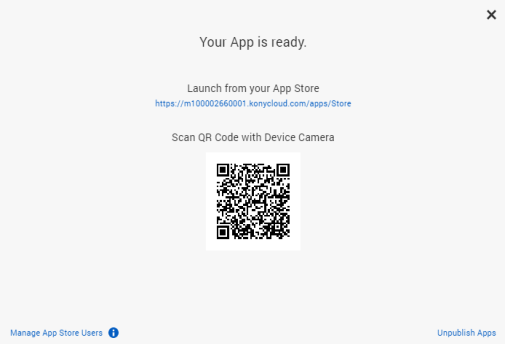
- Type the App Store link on a browser on your mobile or scan the displayed QR code to launch the Enterprise App Store on your mobile.
- Your published app will be listed with the same name as your Visualizer Project. Click on GET to fetch the app from the Enterprise App Store and launch it on your device.
The logo of the application will be the image you set in Project Settings > Native > Application Logo. If you do not set an Application Logo, a default icon is displayed as the application logo.
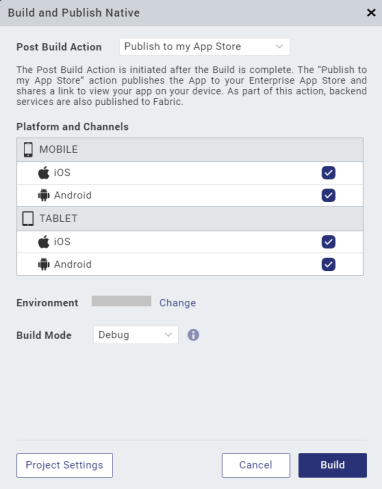
The Publish to my App Store action publishes the application to your Enterprise App Store and shares a link and a QR code to view the app on your mobile. As a part of this action, backend services are also published to Quantum Fabric.
NOTE: To publish an app to the Enterprise App Store logging in to your Quantum Account is mandatory.
NOTE: For the first time, any user can access the published app, unless access to the app store is restricted by managing app store users.
Build and then Publish
To build and then publish an application you can choose either of the other Post Build Actions available. The other two Post Build Actions are:
- Run on my Device: The Run on my Device action installs the application to your connected device and enables you to view the app on your device.
- Generate Native App: The Generate Native App action generates the binaries for your Native application and saves it on your file system.
Publish Web Apps to the Enterprise App Store
To build and publish a Web application, follow these steps:
- From the main menu on Quantum Visualizer, select Build.
- From the context menu, select Build and Publish Web.
The Build and Publish Web window appears. - Select the channels for which you want to build the application.
- You can choose to change the cloud environment on which your app will be published. To do so, click Change next to the Environment option.
To change the Environment from the Project Settings, go to Project Settings > Quantum Fabric and from the drop-down menu, select an environment. - Enable the Publish to my App Store option.
- From the Build Mode drop-down list, select a build mode.
- Click Build. The build generation begins. As a part of this action, backend services are also published to Quantum Fabric.
You can check the status of your build in the Build tab. Before the actual build starts, various actions such as project compression and upload of the compressed project to the cloud are performed. This process may take some time.
-
Upon successful build and publish, a confirmation window appears. The window will display a link and a QR code to view the Enterprise App Store on a browser of your mobile device.

-
Type the App Store link on a browser of your mobile or scan the displayed QR code to launch the Enterprise App Store on your mobile device.
NOTE: When an App is published for the first time, any user can access the app, unless access to the app store is restricted by managing app store users.
- The published app will be listed on the Enterprise App Store with the same name as your Visualizer Project. Click on Open to fetch the app from the Enterprise App Store and launch it on a browser of your mobile.
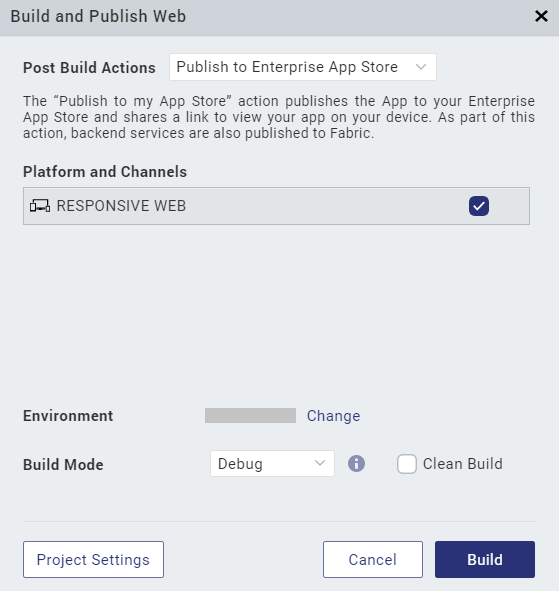
NOTE: To publish an app to the Enterprise App Store, it is mandatory to log on to your Quantum Account.
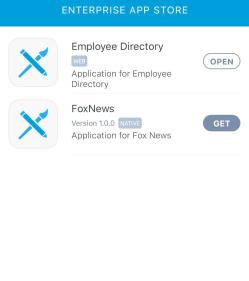
Manage App Store Users
The Enterprise App Store(EAS) is an application to distribute your native apps. An organization that uses Quantum EAS can customize the user access based on their requirements. To view and manage the active user list for any Quantum EAS account there exists the Manage App Store Users window within Kony Visualizer.
You can access this window from the confirmation window that appears after the successful publish of an app to the EAS. The link to the application on the Enterprise App Store can be accessed by clicking on the My App Store button on the Header of the Visualizer App Canvas. You can also access the link to the application on the Enterprise App Store from the Project Settings > Quantum Fabric page.
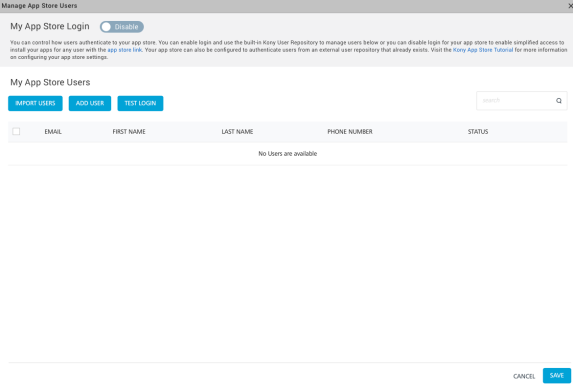
To Manage app store users from Visualizer, do the following:
- From the confirmation window, click on the Manage App Store Users link. The Manage App Store Users window appears.
Using this window, you can manage users, enable access to install your apps for any user that has the app store link. - You can import users, add new users and perform a test login from the Manage App Store window. These actions are specific to Quantum user Repository.
- On the Manage App Store Users window, toggle the My App Store Login switch to enable the access settings. You can now control the user authentication and access to your app store.
- You can go to Quantum Fabric and enable authentication to authenticate users with the Identity services available in the Manage App Store Users window.
NOTE: By default, the Manage Users Login is disabled. The default authentication type for Quantum EAS is Quantum user Repository. So when an app is published to the EAS, all users registered in the Quantum user Repository are authorized to access this app for the first time. You can change the authentication from Quantum Fabric.
You can set up an identity service based on the type of the users who are allowed to access your application. For example: To restrict access to your organisation's internal audience, use Microsoft Active Directory authentication. To allow access of your application to a larger audience, you can use enterprise identity providers (Microsoft Active Directory, Kony SAP Gateway, Open LDAP, OAuth 2.0, Salesforce, Custom Identity Service, SAML, SiteMinder or Quantum user Repository authentication) and social identity providers (Google, LinkedIn, Instagram, Amazon, Microsoft, Yahoo, BOX, Facebook).
NOTE: Setting up an identity service is optional. You can choose not to implement any authentication services for your application.
IMPORTANT: For more information on Managing the Enterprise App Store, refer to Enterprise App Store on Quantum Fabric.
Cancel publish to the EAS
You can cancel the publish during the build and publish process. Click on the Cancel button available in the Build tab in Visualizer to cancel the build and publish process at any time.
You cannot open a different project when one project is being built in Visualizer.
Unpublish an App from the EAS
Once your app is published to the Enterprise App Store (EAS) , if you want to unpublish it for any reason, you can do so in Quantum Visualizer. The Unpublish option is available in the confirmation window that appears after the successful publish of an app to the EAS.
To unpublish a Quantum Visualizer app from the EAS, follow these steps:
- In Visualizer, from the blue header above the App Canvas, click My App Store.
The My App Store dialog box appears.
- Click Unpublish App. The Select Apps to unpublish dialog box appears.
- Select the channels from which you want to unpublish the app, and then click Unpublish. The progress of the app-unpublish process appears in the Build tab. Once the app is successfully unpublished, a confirmation message appears.
NOTE: You can also unpublish the published app through the Quantum Fabric console. For more information, refer Enterprise App Store on Quantum Fabric.

